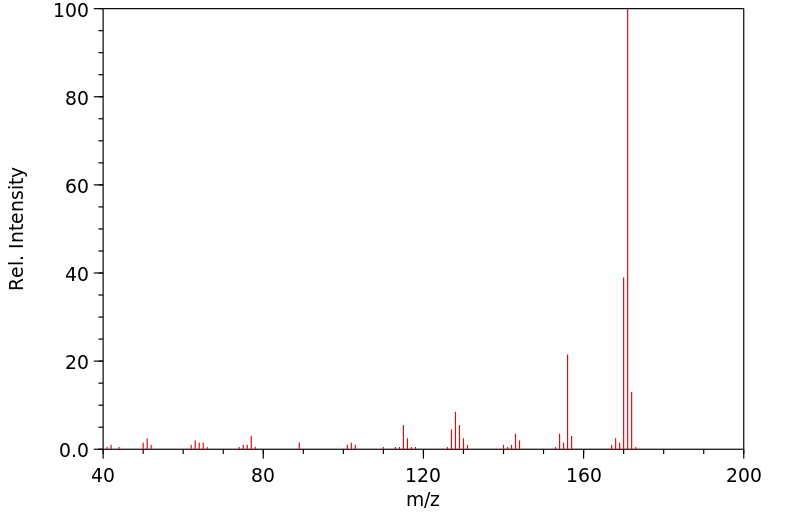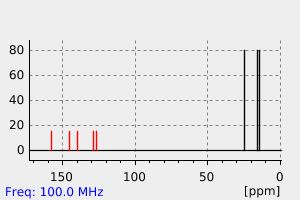2,3,4-三甲基喹啉 | 2437-72-1
中文名称
2,3,4-三甲基喹啉
中文别名
——
英文名称
2,3,4-trimethylquinoline
英文别名
2,3,4-Trimethyl-chinolin
CAS
2437-72-1
化学式
C12H13N
mdl
MFCD09240593
分子量
171.242
InChiKey
VBCFHWSPNHEYGE-UHFFFAOYSA-N
BEILSTEIN
——
EINECS
——
-
物化性质
-
计算性质
-
ADMET
-
安全信息
-
SDS
-
制备方法与用途
-
上下游信息
-
文献信息
-
表征谱图
-
同类化合物
-
相关功能分类
-
相关结构分类
物化性质
-
熔点:92 °C
-
沸点:156-158 °C(Press: 12 Torr)
-
密度:1.034±0.06 g/cm3(Predicted)
-
保留指数:1616
计算性质
-
辛醇/水分配系数(LogP):3.3
-
重原子数:13
-
可旋转键数:0
-
环数:2.0
-
sp3杂化的碳原子比例:0.25
-
拓扑面积:12.9
-
氢给体数:0
-
氢受体数:1
SDS
反应信息
-
作为反应物:描述:2,3,4-三甲基喹啉 在 镍 作用下, 生成 1,1,2,3,4-pentamethyl-1,2,3,4-tetrahydro-quinolinium; iodide参考文献:名称:v. Braun; Gmelin; Petzold, Chemische Berichte, 1924, vol. 57, p. 388摘要:DOI:
-
作为产物:描述:1-(2-氨基苯基)乙醇 在 C2H2F5NO4S2 、 对甲苯磺酸 、 溶剂黄146 、 sodium nitrite 作用下, 以 水 、 1,2-二氯乙烷 为溶剂, 反应 4.5h, 生成 2,3,4-三甲基喹啉参考文献:名称:内部炔烃的无过渡金属碳氨化-轻松获得多取代喹啉摘要:在协同的布朗斯台德酸基催化剂体系的存在下,实现了未活化的炔烃向高度取代的喹啉的无过渡金属无碳氨化反应。该机制被确认为...DOI:10.1039/c5cc10460b
文献信息
-
Ionic Liquid-Promoted Regiospecific Friedlander Annulation: Novel Synthesis of Quinolines and Fused Polycyclic Quinolines作者:Sanjay S. Palimkar、Shapi A. Siddiqui、Thomas Daniel、Rajgopal. J. Lahoti、Kumar V. SrinivasanDOI:10.1021/jo035153u日期:2003.11.1Several room-temperature ionic liquids (ILs) based on 1-butylimidazolium salts with varying anions were synthesized and evaluated for the preparation of biologically active substituted quinolines and fused polycyclic quinolines using the Friedlander heteroannulation reaction. On screening, 1-butylimidazolium tetrafluoroborate [Hbim]BF4 was found to be the best ionic liquid for the heteroannulation reaction
-
QUINOLINIUM ION DERIVATIVES, PROCESS FOR THE PRODUCTION OF THE DERIVATIVES, PRODUCTS MADE BY USING THE SAME, AND REDUCTION AND OXIDATION METHODS WITH THE DERIVATIVES申请人:Fukuzumi Shunichi公开号:US20100004454A1公开(公告)日:2010-01-07An electron donor-acceptor dyad is provided that can provide a charge-separated state with longevity and not only high oxidizing power but also high reducing power. A compound of the present invention is a quinolinium ion derivative represented by the following formula (I), a stereoisomer or tautomer thereof, or a salt thereof: where R 1 is a hydrogen atom or an alkyl group, and Ar 1 to Ar 3 each are a hydrogen atom or an electron-donating group. The compound of the present invention has the above-mentioned structure and therefore can provide a charge-separated state with longevity and not only high oxidizing power but also high reducing power and can be used for various products such as photocatalysts, photosensitizers, dyes, oxidants, reductants, dye-sensitized solar cells, and organic EL devices.
-
PROCESS FOR PRODUCTION OF OXIDATION REACTION PRODUCT OF AROMATIC COMPOUND申请人:Ohkubo Kei公开号:US20120171111A1公开(公告)日:2012-07-05The present invention provides a process for producing an oxidation reaction product of an aromatic compound, having excellent environmental load reduction performance, cost reduction performance, etc. Provided is a process for producing an oxidation reaction product of a raw material aromatic compound by reacting the raw material aromatic compound with an oxidizing agent. The process further uses an electron donor-acceptor linked molecule. The process includes the step of: reacting the electron donor-acceptor linked molecule in an electron-transfer state, the oxidizing agent, and the raw material aromatic compound, thereby generating an oxidation reaction product resulting from oxidation of the raw material aromatic compound.本发明提供了一种生产芳香化合物氧化反应产物的工艺,具有优异的环境负荷减少性能、成本降低性能等。提供了一种通过将原料芳香化合物与氧化剂反应来生产原料芳香化合物的氧化反应产物的工艺。该工艺进一步使用了电子给体-受体连接分子。该工艺包括以下步骤:在电子转移状态下将电子给体-受体连接分子、氧化剂和原料芳香化合物反应,从而生成由原料芳香化合物氧化产生的氧化反应产物。
-
REACTIVE COMPOUND申请人:SUMITOMO CHEMICAL COMPANY, LIMITED公开号:US20150353583A1公开(公告)日:2015-12-10A reactive compound represented by the following formula (I): [In the formula (I), Z represents a divalent group. A plurality of Y may be the same or different, and represent a monovalent boronate residue having at least one hydroxyl group, Ar 1 and Ar 2 may be the same or different, and represent a trivalent aromatic hydrocarbon group or a trivalent heterocyclic group.].
-
Homogeneous catalysis, heterogeneous recycling: a new family of branched molecules with hydrocarbon or fluorocarbon chains for the Friedländer synthesis of quinoline under solvent-free conditions作者:Lei Fang、Jianjun Yu、Ying Liu、Anyin Wang、Limin WangDOI:10.1016/j.tet.2013.10.029日期:2013.12A new family of branched catalysts with hydrocarbon or fluorocarbon chains was used to catalyze Friedländer reaction between 2-aminoarylketones and α-methylene ketones under solvent-free conditions in good to excellent yields. The catalysts exhibit temperature-dependent solubility and such a thermomorphic character allows them to be recovered by filtration conveniently at room temperature and reused
表征谱图
-
氢谱1HNMR
-
质谱MS
-
碳谱13CNMR
-
红外IR
-
拉曼Raman
-
峰位数据
-
峰位匹配
-
表征信息
同类化合物
(S)-4-(叔丁基)-2-(喹啉-2-基)-4,5-二氢噁唑
(SP-4-1)-二氯双(喹啉)-钯
(E)-2-氰基-3-[5-(2,5-二氯苯基)呋喃-2-基]-N-喹啉-8-基丙-2-烯酰胺
(8α,9S)-(+)-9-氨基-七氢呋喃-6''-醇,值90%
(6,7-二甲氧基-4-(3,4,5-三甲氧基苯基)喹啉)
(1-羟基-5-硝基-8-氧代-8,8-dihydroquinolinium)
黄尿酸 8-甲基醚
麻保沙星EP杂质D
麻保沙星EP杂质B
麻保沙星EP杂质A
麦角腈甲磺酸盐
麦角腈
麦角灵
麦皮星酮
麦特氧特
高铁试剂
高氯酸3-苯基[1,3]噻唑并[3,2-f]5-氮杂菲-4-正离子
马波沙星EP杂质F
马波沙星
马来酸茚达特罗杂质
马来酸茚达特罗
马来酸维吖啶
马来酸来那替尼
马来酸四甲基铵
香草木宁碱
颜料红R-122
颜料红210
颜料红
顺式-苯并(f)喹啉-7,8-二醇-9,10-环氧化物
顺式-(alphaR)-N-(4-氯苯基)-4-(6-氟-4-喹啉基)-alpha-甲基环己烷乙酰胺
非那沙星
非那沙星
青花椒碱
青色素863
雷西莫特
隐花青
阿莫地喹-d10
阿莫地喹
阿莫吡喹N-氧化物
阿美帕利
阿米诺喹
阿立哌唑溴代杂质
阿立哌唑杂质B
阿立哌唑杂质38
阿立哌唑杂质1750
阿立哌唑杂质13
阿立哌唑杂质
阿立哌唑杂质
阿尔马尔
阿加曲班杂质43








